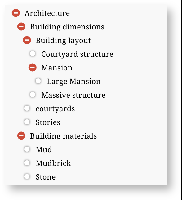Mandala Knowledge Map Philosophy
Knowledge Maps let you build semantic fields or ontologies of terms, which you can then use to label resources you create in Mandala. At the most basic level, Knowledge Maps are terms or tags in a hierarchy. This places a term in the appropriate context. Furthermore, each Knowledge Map term has its own associated metadata, including term definitions, related terms, alternate names, specific GIS locations, and more. You can see all this information using the Knowledge Maps viewers. Whenever you label a resource in Mandala with a Knowledge Map, it links to the Knowledge Map viewer. There are currently two types of Knowledge Maps: subjects and places. Each has its own viewer at mandala.shanti.virginia.edu/subjects and mandala.shanti.virginia.edu/places, respectively. We call the hierarchical grouping of terms a Knowledge Map tree. Subjects and places are built collaboratively, through crowd-sourcing. Ideally, new subjects or places should integrate into the existing trees at https://mandala.shanti.virginia.edu/subjects and https://mandala.shanti.virginia.edu/places. We understand that everyone has different needs for their project, and are happy to implement whatever terms most serve your scholarship. We only ask that you come to meetings open to collaboration and productive conversation. The first step in adding new Knowledge Maps terms is to email the Mandala team at mandala@virginia.edu. We'll set up a meeting to discuss your project.
Before Your Meeting
- Take a look at the existing subject and place trees in Mandala.
You can browse trees by clicking the Search icon () in Subjects or Places. Expand the various categories. Do you see a place where your terms might fit? Are there existing terms you could use?
- Bring an example of a tree.
Ideally, this data will be in the spreadsheet format described below. However, feel free to use anything that conveys how you want your terms placed, like drawings or diagrams.
Building Trees
Subject Trees
Here are some tips for building subject trees:
Make sure your terms can stand alone. While context within the tree enhances subject terms, there are some places within Mandala where terms won't be shown within the tree. Avoiding vague terms like "yes" or "no" make your terms easier to find and use.
Try
Avoid
- Photography
- Color photography
- Grayscale photography
- Photography
- Color
- Yes
- No
- Consider both specific terms (Andean sheep farmers) and general terms (wool). Remember, your terms can really enhance the Mandala project as a whole, and other people may eventually want to use your broader terms.
Place Trees
You should think about whether your places are administrative (ie, the official state of Virginia) or cultural (ie, the Rotunda). These will have different implementations in Places.
You can add alternative names to Knowledge Maps, so you won't need seperate places for official and popular terms – "The Big Apple" and "New York City" should share the same place.
Formatting Trees in a Spreadsheet
Knowledge Map hierarchies in Mandala are built with tree data structures. Each knowledge map term is a node on the tree. You can place a knowledge map term using its parent — that is, the higher-level term the knowledge map falls under. Nodes that fall under a parent are its children. If a node doesn’t have a parent — that is, it’s the highest possible level of the tree – we call it the root node. A node may have many children, but it only has one the parent. In the example above:
- Architecture is the root, since it has no parent
- Architecture is the parent of two children: Building materials and Building dimensions
- Building dimensions is the parent of three children: Building layout, courtyards, and Stories
- Building materials is the parent of three children: Mud, Mudbrick, and Stone
- Building layout is the parent of three children: courtyard structure, Mansion, and Massive structure
- Mansion is the parent of one child: Large Mansion
To format your tree in a spreadsheet, every row represents a node. In the first column, write the node's name. In the second, write the name of the node's parent. If the node is a root, the parent will be blank. Make sure you use consistent names, with consistent capitalization. Here's a table for the sample tree:
| Node | Parent |
|---|---|
| Architecture | |
| Building dimensions | Architecture |
| Building materials | Architecture |
| Building layout | Building dimension |
| Courtyard structure | Building layout |
| Mansion | Building layout |
| Large Mansion | Mansion |
| Massive structure | Building layout |
| courtyards | Building dimensions |
| Stories | Building dimensions |
| Mud | Building materials |
| Mudbrick | Building materials |
| Stone | Building materials |
This spreadsheet will help developers import your terms quickly.
FAQs
What happens once my tree goes live? Can anyone add a term to my tree?
Once you have added a new set of terms to a tree, we hope you'll become the "owner" for that node. That means you can add and delete any children for which that node is a parent. As the node owner, you can let collaborators add children to that term.
How long will it take for the team to add my subjects and places to Mandala?
The timeline will vary. Places may take longer to add than subjects, especially if you need accurate administrative data. In these cases, adding places may take as long as a month. In your meeting, the Knowledge Maps team can give you more accurate time estimates based on your specific needs. Needless to say, you should start the process well before any deadlines.
